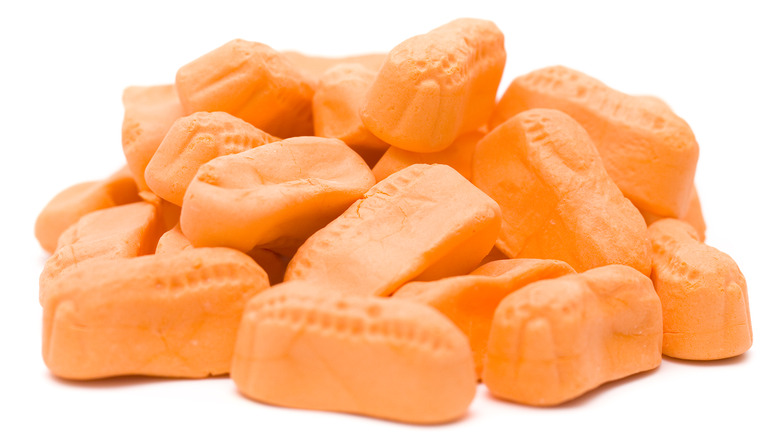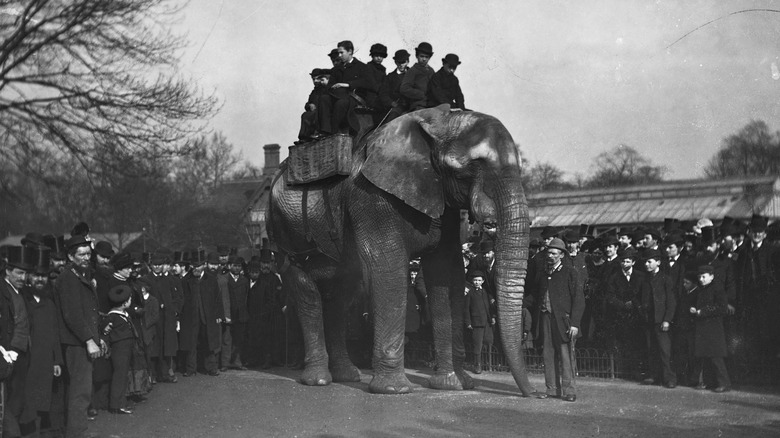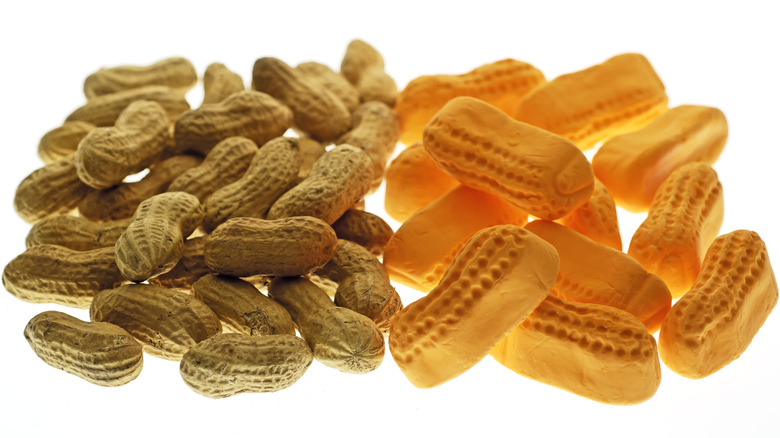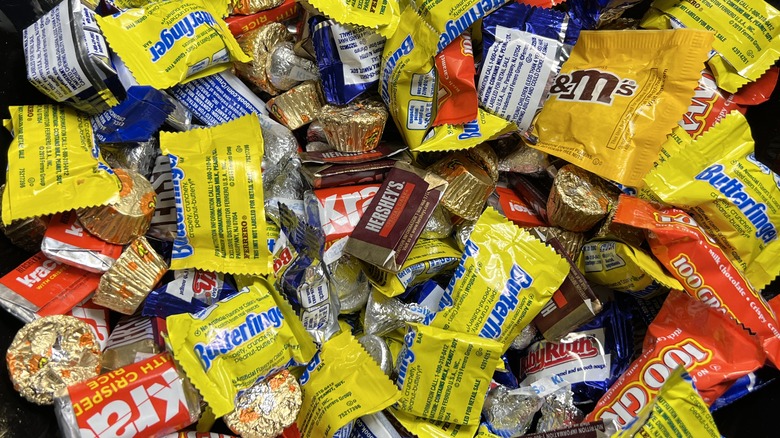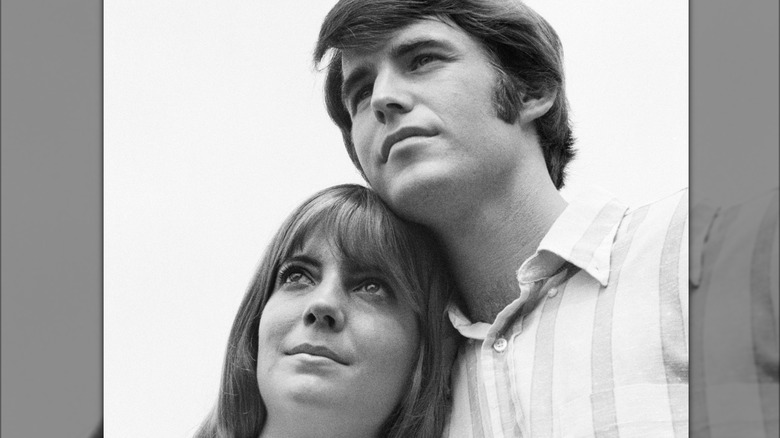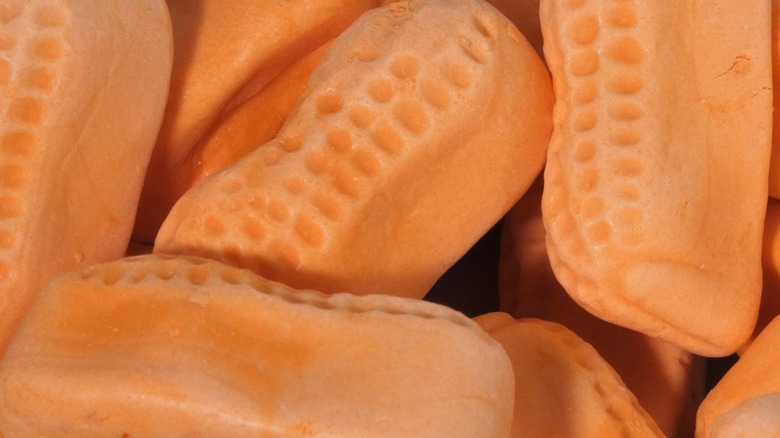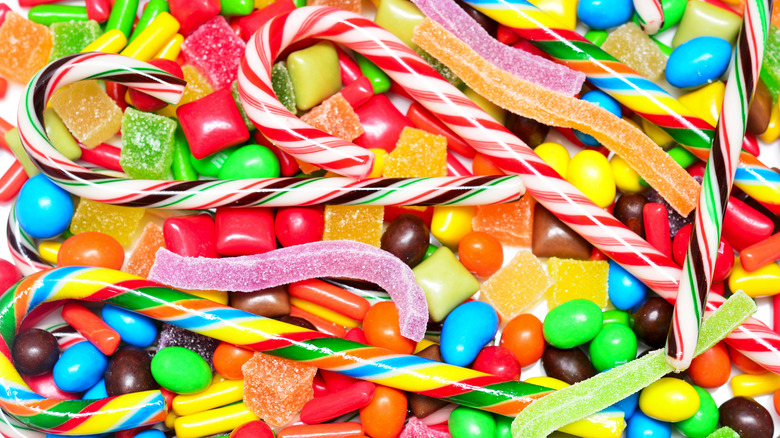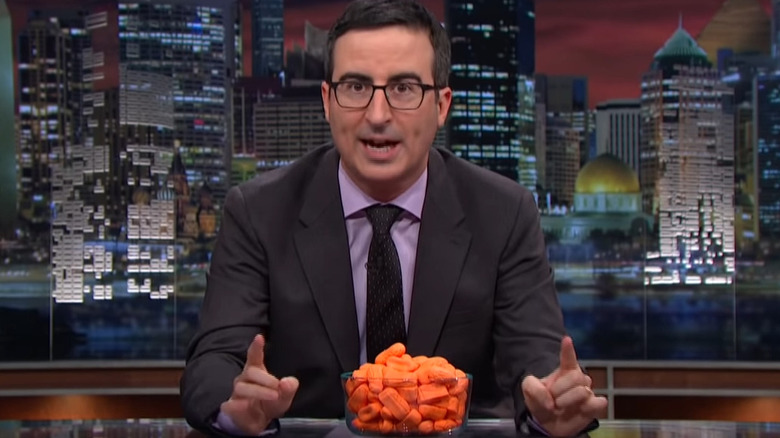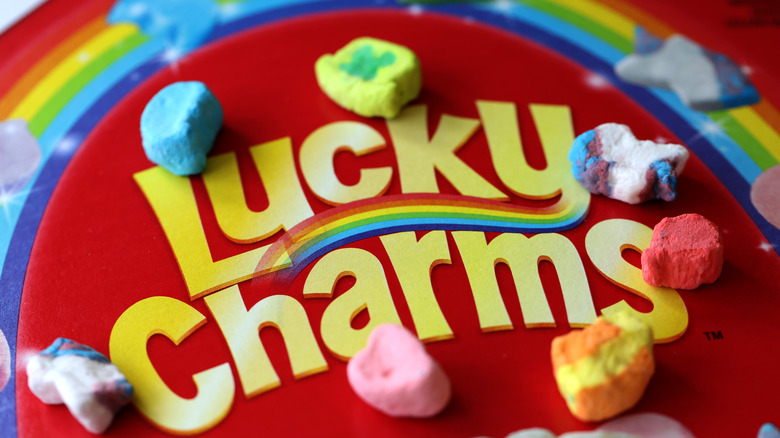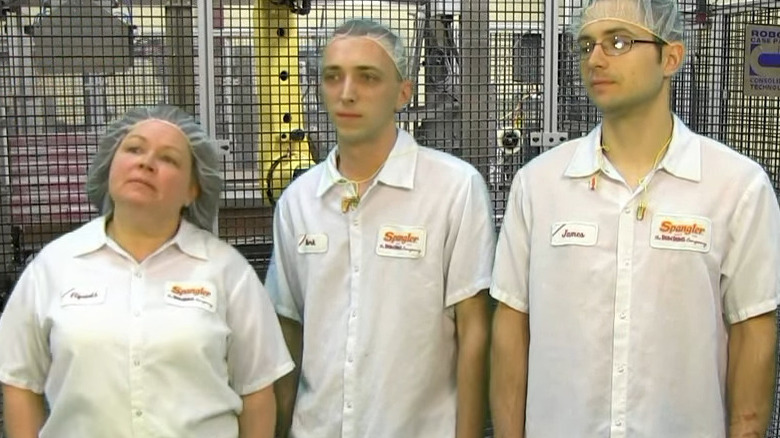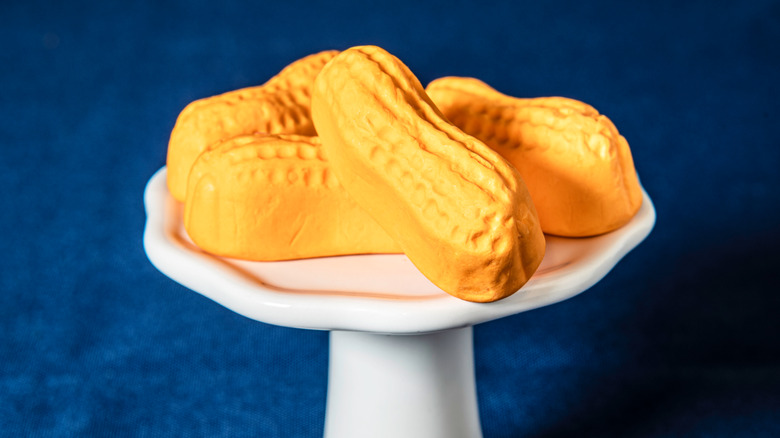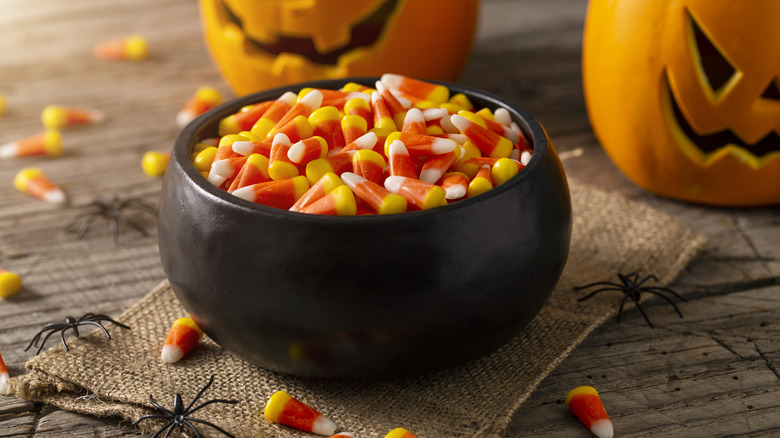Why Circus Peanuts Practically Disappeared
"What's the point of eating candy?" isn't the question we're aiming to ask or answer in this article. But it is an instructive consideration when analyzing why a product like circus peanuts has practically disappeared over the past century or so. After all, if candy has no nutritionally redeeming qualities (a moderately debatable claim on its own), and is solely meant as an occasional snack offering a burst of short-yet-sweet pleasure, well ... why would anyone ever willingly choose to eat circus peanuts?
The candy is neither a peanut nor prominently found at circuses. Circus peanuts are more of an anomaly than anything else in the 21st century. In fact, the antiquated candy is the redheaded (or orange-hued) stepchild of the confectionary world.
Despite being the bane of trick-or-treaters' Halloween candy bags for time immemorial (we presume), circus peanuts somehow remain available to modern candy seekers. And while the incomparably bizarre peanut-shaped (but banana-flavored) candy's century-plus fall from grace is hardly surprising, that doesn't mean the story is boring — or entirely obvious. On that note, allow us to explain why circus peanuts practically disappeared.
Circus peanuts are a relic from the 19th century
Very few foods that were originally popularized before the end of the 19th century remain widely consumed more than 120 years later. Circus peanuts have gone the way of once-popular food items like turtle soup or milk toast and mostly vanished from society. It's a bonafide fact that the spongy, non-peanut-flavored (but peanut-shaped) sweet is an antiquity from another era, as it was originally created at some unspecified point during the 1800s.
It's no mystery why an odd-tasting candy — one that seems to zig when you'd expect (and greatly prefer) that it simply zag — is an afterthought to the modern candy fan. There's a near-infinite number of drastically better candy varieties and brands available in modern times, after all. Back when the supposedly Big Top-inspired snack food was first introduced to the world, though, consumers were limited to whatever penny candies were locally available — and less likely to be as picky as a result.
Of course, we presume the circus peanut baffled customers just as much during their infancy as they do in old age. But seeing how the pickings were overwhelmingly slimmer in a time before today's overabundance of candy options, it's clear that whoever first conceived of these absurd candies hit their intended mark.
A peanut-shaped, orange-hued, banana-flavored candy is intellectually confounding
When you see a food item designed to resemble a peanut, you likely know what to expect from its taste (hint: it's not bananas). Along those lines, if a food item is the color orange, well ... you'd obviously expect that food to be drenched in banana flavor, right? Of course not — and therein lies a likely explanation for the demise of circus peanuts over time. The notion of a peanut-shaped and orange-hued food that somehow doesn't taste like either peanuts or oranges is disconcerting to the human brain.
Thanks to some combination of genetics and environment (who said it always has to be nature versus nurture?), most of us develop a general set of expectations for how food should taste and feel based on its appearance, smell, and texture. In that sense, it's no real wonder that a baffling confection that completely defies our brain's expectations (taste and texture-wise) hasn't captivated the entire population.
Beyond the misleading (and still puzzling) flavor profile offered by the circus peanut, their generally soft and chewy texture isn't always neurologically appreciated, either. Between evolution and human experience, when we see a peanut-shaped item, we expect it to be crunchy rather than soft. In other words, the sheer design of circus peanuts is simply too much for many people to wrap their heads around.
The lack of consistent individually-wrapped packaging is unsettling
When trick-or-treaters refused to eat the homemade Halloween cookies made by Mrs. Weir (Becky Ann Baker) on the third episode of "Freaks and Geeks," it broke our hearts — even if we could understand the apprehension felt by those (fictional) parents about non-pre-packaged (and potentially tainted) treats. Of course, the urban legend surrounding poisoned Halloween candy appears largely overblown. But that irrational fear seems to indicate one reason for circus peanuts' drastic decline since the mid-20th century: their loose packaging is much less secure than most consumers prefer.
Discounting the candy's unconscionable flavor profile for a moment (we know that's a challenge), it's hard to imagine a more obvious explanation for circus peanuts' general absence during trick-or-treating than a lack of individual packaging. Other somewhat archaic candy brands have remained prevalent during the October holiday thanks to individually wrapped fun-size options, after all (we're looking at you, Tootsie Rolls).
To be fair, it does appear at least one company offers a circus peanut product where each candy is individually wrapped. But since those appear to be the exception rather than the rule, this particular reason for the modern disappearance of circus peanuts sort of explains itself.
They're simply not very appetizing
In the previous slide discussing a lack of individually wrapped packaging found with circus peanuts, we asked readers to momentarily forget the candy's actual flavor. Now, we'd like you to remember precisely how the humble circus peanut tastes. Assuming you have, in fact, previously sampled this century-plus-old sweet treat, you know it offers a hint of banana within a marshmallowy texture; and this, to be blunt, provides a crystal clear reason why circus peanuts have practically vanished from the world — they just aren't very good.
We're guessing some readers may not be entirely aware of the unappetizing makeup of circus peanuts. After all, it often feels like circus peanuts are one of those near-mythical foods that everyone in the world has an opinion on ... but virtually no one's actually tried first-hand. Still, considering the public discourse surrounding circus peanuts almost always hinges upon their mouthwatering taste (as in the watery mouth feeling you get just prior to vomiting), it's not exactly bold to declare the candy is universally disliked.
We can't (or, rather, won't) say whether circus peanuts are the least appetizing candy in existence. But they're certainly a worthy contender for that title — hence their lack of modern sales sizzle.
Circus peanuts seemingly remain available solely for nostalgia
The power of nostalgia can be staggering to consider. After all, what else but an overarching longing for the good old days could make the world believe Crystal Pepsi was anything but an abject failure? This force of nature may be solely responsible for our decision to add the word "practically" to this article's headline. One of the only verifiable reasons why circus peanuts haven't completely disappeared appears to be nostalgia.
Perhaps an individual has their own fond memories of personally consuming circus peanuts, or of doing so with an older relative during childhood. Maybe a person is driven by the desire to purchase and eat a candy that was popular well before they were born — like circus peanuts. Whatever the specific type of nostalgic pull, that interest in occasionally reliving the past seems largely responsible for keeping circus peanuts on store shelves.
Since "few candies ... have survived as long as circus peanuts," as candy purveyor Jon Prince noted to USA Today in 2006 (via CandyFavorites.com), we'd bet their ability to conjure days of yore will keep them around for the foreseeable future, as well.
Even manufacturers of circus peanuts aren't necessarily big fans
If there's one thing we took away from "Scarface" — the 1983 Al Pacino-starring remake, not the 1932 Al Capone-inspired original — it's that you "don't get high on your own supply" (it's Business 101, people). It may seem as though a certain circus peanut manufacturer took this mantra to heart before starting their career making and selling the candy. But the reason why some circus peanut producers don't eat the final product has nothing to do with maintaining profitability. Rather, it's because they don't actually enjoy eating circus peanuts. That's right: in 2006, Steve Kerr, the VP of operations for Spangler Candy, one of the last circus peanut manufacturers in the nation, said he didn't like the candy.
Frankly, it's perfectly reasonable (if a bit rude) for us to declare circus peanuts are an abomination in the confectionary world. But to discover that the folks tasked with bringing the old-timey treat to the masses may, in fact, share that point of view is like biting into a circus peanut for the first time — surprising, and a little disorienting.
If nothing else, this revelation adds further context for circus peanuts' slim market share in the 21st century. Because if the people making the candy can't get enthused about it, why would the rest of us?
They can't compete with other candy brands on the market
It's stunning to consider how many gloriously delightful candy brands are available to the modern consumer. Reese's, Snickers, Twix, Almond Joy, Butterfinger, Three Musketeers — you get the picture. And those six choco-riffic candy bars aren't even the tip of the iceberg when it comes to the seemingly never-ending options at one's disposal. Of course, the abundance of rich chocolate (or fruit-flavored, or caramel-centric) candy varieties that have been introduced since circus peanuts' creation illustrates one of the very reasons they disappeared over time: there are simply better options.
Whether or not circus peanuts are the absolute worst candy on the market in the 21st century is difficult to determine (though some would agree with that assessment). Either way, as evidenced by the half-dozen well-loved candy bars we mentioned in the previous paragraph, the candy game is a fierce competition.
Maybe you're one of those rare mega-fans of circus peanuts and think they belong in a league by themselves. You'd clearly be in the minority with that opinion. So while we'll refrain from listing any more candy brands, the fact that we could go on (and on) listing a bevy of more popular modern candy companies and varieties says it all.
The candy's entire existence defies all logic
Objects that exist in the world are supposed to make sense. There's a presumed order to things, after all, and a specific logic that dictates what we should expect to see and experience throughout life. Of course, the sheer fact that circus peanuts are a real food product — and not something a preschooler imagined and then molded out of Play-Dough — is confounding for a multitude of reasons.
For starters, why don't they taste like peanuts? Is it so much to ask that a product both named and shaped after the basic shelled legume — one that masquerades as a nut – actually offers that delectable flavor? Beyond this baffling reality, if anyone on earth can satisfactorily explain why the circus peanut needs to be banana-flavored (as opposed to, say, just sweetened without a specific flavoring), we'd love to hear it.
Perhaps the rumor noted in "Andrew Zimmern's Field Guide to Exceptionally Weird, Wild, & Wonderful Foods" — that the banana flavor results from "a freak banana-oil accident" — is true. Even if it is, though, it does little to further justify the peanut-shaped, marshmallow-soft candy's existence in the first place.
Circus peanuts' greatest societal contribution may be inspiring Lucky Charms
If you believe the tale told by General Mills regarding a certain magically delicious breakfast cereal, the most important culinary creation resulting from circus peanuts' century-plus history has nothing to do with the candy — and everything to do with the marshmallow bits found in Lucky Charms (known as marbits). It appears experiments involving a bowl filled with Cheerios and topped with chopped circus peanuts led to the development of Lucky Charms.
It may not be immediately apparent how this fun fact regarding the creation of Lucky Charms explains why circus peanuts have practically disappeared throughout the last century — and to be perfectly honest, there's no real direct link between the two. But the fact that Lucky Charms' consumer appeal and pop cultural impact are head-and-shoulders above circus peanuts says something about the candy's status in the modern world — as does the lack of actual circus peanuts found in the final product rolled out by General Mills.
Making circus peanuts requires near-comically precise conditions
It's a well-known fact that nothing in life worth doing will be easy. Of course, while we accept the notion that worthy endeavors require both time and effort, some excessively challenging tasks don't necessarily count as worthy — like, say, the production of circus peanuts. In fact, despite being one of the least popular candies on the market, when it comes to how circus peanuts are actually made, the process is almost laughably difficult.
Apparently, circus peanuts are enormously challenging to nail — and have even been described by Spangler Candy as the most difficult candy, production-wise, made by the company. More than anything, it seems ensuring the final product retains an appropriate amount of moisture is the trickiest part, since threading that needle is absolutely crucial to creating the circus peanut's unique texture.
Additionally, the surprisingly time-consuming preparation process for making circus peanuts includes a 24-hour drying period in a temperature-controlled room — meaning the finicky candy takes far longer to make than you'd likely prefer as a candy manufacturer.
They haven't been advertised consistently in at least half a century
Circus peanuts trace so far back that you might think they're a relic from the Roman Empire — and, in fact, the last time the public saw an actual advertisement for the ancient candy variety was during that fateful time period. We're joking, of course (even the Romans would have recognized the brightly-colored so-called candy wasn't worthy of promotion). But the fact that very few people can likely recall a time when circus peanut advertisements existed points to a key reason for their decline into relative obscurity.
We couldn't uncover a single modern ad for circus peanuts in all our research — at least not one from within the past 50 years. More than that, it's not entirely clear whether the handful of ads we found from the mid-20th century were for the candy itself. It appears just as likely those retro advertisements were for actual peanuts — as in, you know, real peanuts — rather than the peculiar confection.
Either way, it's impossible to deny circus peanuts have lacked any sort of consistent or prominent marketing since before the moon landing. Then again, we doubt an uptick in commercials would do much to improve their stock among 21st-century candy consumers.
Circus peanuts lack a seasonal connection like candy corn or Peeps
Did you know that prior to the 1940s, circus peanuts were sold as seasonal candy in the springtime? You didn't? Well, perhaps that's because there's nothing inherently spring-like about circus peanuts. In fact, they were only a spring snack due to preservation limitations of the day (which were resolved with the invention of a polyethylene film). Along those lines, it seems the lack of a clear-cut connection to any specific season or holiday has hamstrung consumer interest in circus peanuts over time.
The lack of an obvious kinship with Halloween, Christmas, Valentine's Day, Easter, or any other holiday where candy is prominently pushed upon society hasn't helped circus peanuts in the long run. For instance, just as many individuals may disdain candy corn as circus peanuts — but at least candy corn is visually connected to Halloween through its color scheme (and seasonally appropriate, given real corn is often harvested in the fall).
It's tough to say whether circus peanuts would be more popular if the world associated them with a major holiday. But if the look, feel, and taste of circus peanuts remained the same in such a scenario, we wouldn't bet on it.
